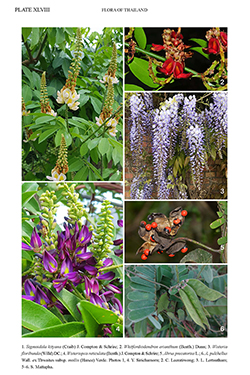e-Flora of Thailand
Volume 4 > Part 3 > Year 2020 > Page 476 > Leguminosae-Papilionoideae > Whitfordiodendron
Whitfordiodendron erianthum (Benth.) Dunnwfo-1200001681
Bull. Misc. Inform. Kew 1912(8): 364. 1912; J.Compton et al., Phytokeys 125: 76. 2019.— Milletta eriantha Benth. In Miq., Pl. Jungh.: 250. 1852; Miq., Fl. Ind. Bat. 1: 150. 1855; Baker, Fl. Brit. India 2(4): 108. 1876; Prain, J. Soc. Bengal, Pt. 2, Nat. Hist. 66(2): 363. 1897.— Adinobotrys erianthus (Benth.) Dunn, Bull. Misc. Inform. Kew 1911(4): 194. 1911; Ridl., Fl. Malay Penins. 1: 586. 1922.— Padbruggea eriantha (Bent.) Craib, Fl. Siam. 1: 397. 1928.— Whitfordiodendron erianthum (Benth.) Merr., Pap. Mich. Acad. Sc. Arts Lett. 19: 160. 1934.— Callerya eriantha (Benth.) Schot, Blumea 39(1–2): 19. 1994. Plate XLVIII: 2.
Accepted Name : This is currently accepted.
Description : Woody climber. Stipules lanceolate, 4 by 1 mm, outside hairy, inside glabrous. Leaves: petioles 5–8 cm long, sparsely hairy; pulvinus ca 10 mm long, sparsely hairy; rachis 2.5–4 cm long, sparsely hairy; ultrajugal part 1–2 mm long. Leaflets 5, opposite; petiolules 7–10 mm long, hairy; lamina; terminal leaflet obovate, somewhat orbicular, slightly larger than lateral ones, 10–13 by 5.5–10 cm, apex acute to acuminate, acumen up to 15 mm long, base round to cuneate; lateral ones 6–11 by (3.5–)5–7 cm, elliptic, ovate to obovate, apex acute to acuminate, base cuneate, margin entire; upper surface glabrous, lower surface hairy with appressed hairs, coriaceous, shiny; lateral veins 6–7 pairs; stipels absent. Inflorescences panicles up to 10 cm long, axillary or terminal, densely tomentose; rachillae up to 17 cm long, sometime undeveloped and forming a racemose-like inflorescence; floral bracts broadly ovate, enclosing a young floral bud, 8–9 by 4–5 mm, apex acute, margin densely hairy, densely hairy outside, hairy in upper half inside; bracteoles inserted at base of calyx lobes, 5–8 by 4–5 mm, margin densely hairy, both sides densely tomentose, persistent; pedicels 2.5–3 mm long, densely tomentose. Calyx tube ca 4.5 mm long; upper lobes connate, slightly separate at apex; lower lobes 4–5 by 3–4 mm, median lobe larger than others two, apex acute, margin densely hairy, both sides densely tomentose. Corolla deep pink to red: standard deep pink to red, elliptic, ca 20 by 18 mm, claw ca 2 mm long, apex acute, base without basal callosities, margin entire, inflexed, outside densely sericeous, inside glabrous; wings oblong, 14–15 by 4–5 mm, base auriculate with auricles 1.5 mm long, apex acute to rounded, margin hairy, hairy along margin and upper part, inside glabrous, claw ca 4 mm long; keel falcate, 18–20 by 5–6 mm, apex acute to rounded, base auriculate with auricles 1.5 mm long, outside ciliate along margin, inside hairy in upper part; claw ca 4 mm long. Stamens: staminal tube 12–15 mm long, glabrous, free part 6–7 mm long; anthers oblong, 1.5 by 0.5 mm, glabrous. Disc tubular, slightly lobed, ca 2 mm long, glabrous. Ovary densely hairy, ca 12 mm long, 2-ovuled; stipe ca 5 mm long; style 10 mm long, hairy. Pods elliptic, 5–6 by 3.5–6 cm, densely brown tomentose, rugose, reticulate with distinct transverse lamellae, usually not contracted between seeds. Seeds 1–2, lenticular, 4–4.5 by 3–3.5 cm.
Thailand : PENINSULAR: Songkhla (Ton Lat Falls, Na Thawi), Narathiwat (Bacho, Waeng).
Distribution : Malay Peninsula (type), Sumatra, Borneo.
Ecology : Evergreen forests, ca 50 m alt. Flowering: July–September; fruiting: October.
Vernacular : Thong khem (ทองเค็ม)(Peninsular).

